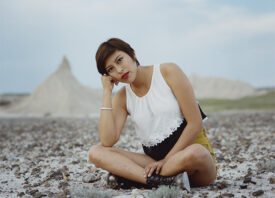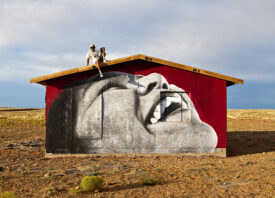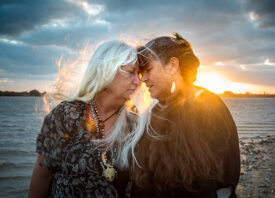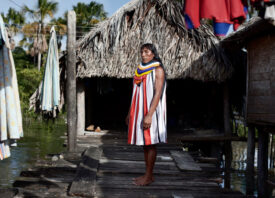Search this site
Facebook App Celebrates Native American Heritage With Stunning Photographs

“Native women are incredibly strong and resilient,” the Chemehuevi photographer Cara Romero tells us. “We come from a long line of women that have fought to hold the very fabric of our Native communities together for hundreds of years through genocide and colonization.” Romero’s First American Girl series works to honor that long line of women, beginning with those closest to her.
The portrait project requires the construction of life-sized doll boxes, filled with the cultural accessories of modern Native American women, made in collaboration with the women themselves. The portrait of mother-and-daughter duo Julia and Jocelyn Romero, for example, includes elements like Percy Romero’s homegrown Cochiti blue corn and Julia’s great grandfather’s Cochiti drum. The doll box features Cochiti wild spinach designs, created by Daniel McCoy.
Julia & Jocelyn is one of fifteen artworks featured in a photo gallery by Meta Open Arts, released in November as part of Native American Heritage Month. In all, the gallery includes five photographers: Adam Sings in The Timber, Coyote Park, Brian Adams, Eugene Tapahe, and Cara Romero. The work spans genres, from the fine art portraiture of Romero to the photojournalism of Adam Sings in The Timber.


Coyote Park collaborates with their 2Spirit and trans family, while Eugene Tapahe shares pictures from Art Heals: The Jingle Dress Project, inspired by the healing power of the Ojibwe jingle dress. Brian Adams takes us to Alaska, documenting life in Kaktovik, Shishmaref, and his father’s home village of Kivalina.


“I think [this gallery] means that we are helping to tell a story that we hope collectively begins to change the narrative for Native Peoples,” Romero says. “It is important that we tell our own stories, because those stories come across as so much more truthful. That truthfulness lends itself to trust from within my community.” As she reminds us, we still have a long way to go: “Native artists need help with scholarships, placement, sponsorship, and opportunities.”


While the artists in the Facebook gallery aren’t limited by genre or location, one thing they all share is an affinity for magical light–from Tapahe’s pictures on Cannon Beach, Oregon, the Native land of the Chinook, Clatsop, and Nehalem people, to Adams’s picture of kids in Kaktovik, still illuminated by sunlight at 10:00 PM.

Romero still remembers when, as a child, her grandpa would wake her up to watch the sunrise. “He would say, ‘get up! get up! the sun is coming!’” she tells me. “We would go outside together and lay on the lawn chairs and watch the sunrise.” The artist’s family, from her grandfather to Julia and Jocelyn, continues to serve as one of her greatest inspirations.

“The Native women in my photographs are my friends and my family,” she says. “The women in my photographs come from diverse Tribes and regions. They are mothers, students, sisters, and artists. They carry sophisticated Indigenous knowledge bundles that exist against all odds.
“Throughout my life, there was a paucity of Native representation in dominant society and education. I have always wanted to show the world how beautiful and amazing Native women are today. I hope the women that participate in the photographs feel loved when they see the final images of our collaborations. And, I hope they see themselves represented in a way that is from within our cultures. My favorite responses to my photographs are when Native moms and aunties and grandmas want me to work with their daughters or families. It is truly the highest honor.”
You can see the Native American Heritage Month photography gallery by Meta Open Arts here.





